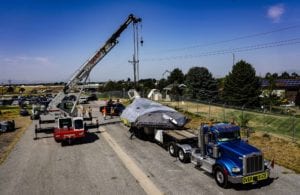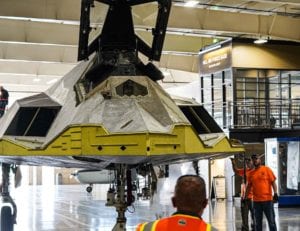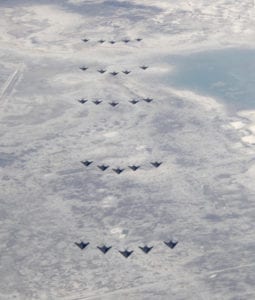
F-117 Nighthawk stealth fighter “Midnight Rider” #799, arrives on flatbed truck at Hill Aerospace Museum
Have you ever transported an F-117 Nighthawk from one state to another, then positioned it into a museum gallery? If you haven’t, trust us, it’s no easy task. You have to secure permits, coordinate the logistics, arrange the proper escorts, reorganize an entire gallery full of aircraft, and much more. And did we mention construction? When you’re moving an F-117 from Nevada to Utah and pass through an expansive construction zone, sometimes you have to find a 112 mile detour—not easy when moving a stealth fighter on a flat-bed truck!

F-117 Nighthawk stealth fighter “Midnight Rider” #799 arrives at Hill Aerospace Museum
But after months of anticipation, countless phone calls and email exchanges, multiple aircraft gallery moves and more than a few frustrating hiccups, the Nighthawk, nicknamed “Midnight Rider,” has finally arrived at the Hill Aerospace Museum. In this blog post, we’ll tell you some interesting facts about the Nighthawk, as well as Hill Air Force Base’s tie to this unique aircraft.
First Stealth Fighter

Two specially painted F-117 Nighthawk stealth fighters, Wright-Patterson Air Force Base, OH. (U.S. Air Force photo/Senior Master Sgt. Kim Frey)
The F-117 Nighthawk was a single-seat, twin-engine, strike-fighter aircraft that met the U.S. Air Force (USAF) requirement for a fighter that was undetectable by enemy radar. Designed by Lockheed Martin’s Skunk Works Division, the F-117 was the first operational stealth aircraft, meaning it was designed “entirely around the concept of evading detection by radar and other sensors.”[1]

SA-2 Surface-to-Air Missile (SAM) on display at National Museum of the United States Air Force, Dayton, OH. (U.S. Air Force photo)
America’s need for a stealth fighter surfaced during the Vietnam War. During this conflict, the Soviet Union built increasingly sophisticated surface-to-air missiles (SAMs) capable of downing U.S. military aircraft. Between 1964 and 1972, nearly 2,500 U.S. military aircraft were destroyed by SAMs, North Vietnamese interceptors, and anti-aircraft artillery. The USAF wanted a fighter aircraft that could avoid radar detection and penetrate enemy airspace in order to deliver weapons against critical targets. In 1976, the Defense Advanced Research Projects Agency (DARPA) issued a contract to Lockheed to build two stealth strike fighters under the code name “Have Blue”.
Secretive Skunk Works

Clarence L. “Kelly” Johnson, chief designer at Lockheed Martin’s Skunk Works facility. (U.S. Air Force photo)
Have Blue was not the first top-secret contract awarded to Lockheed Martin. Its Skunk Works division was founded in 1943 by Clarence “Kelly” Johnson, with the mission of building “the world’s most experimental aircraft and breakthrough technologies in abject secrecy,”[1] Skunk Works’ first team of hand-picked engineers and mechanics developed the F-80 Shooting Star under the cover of a rented circus tent. During the development period, a foul smell from the adjacent manufacturing plant permeated the tent. This reminded engineer Irv Culver of “Skonk Works,” from the comic strip Li’l Abner, the noxious factory that produced moonshine from skunks, old shoes, and other odd ingredients.[2] Over time, the name “Skonk Works” evolved into “Skunk Works,” and became the registered trademark for the company.

Skunk Works entrance plaza, Palmdale, CA. (Photo courtesy of Wikimedia Commons)
Following the Shooting Star, Skunk Works designed the U-2 “Dragon Lady” high-altitude reconnaissance aircraft in 1955. Kelly wrote in his logbook concerning the U-2: “Airplane essentially completed. Terrifically long hours. Everybody almost dead.” Skunk Works then designed the SR-71 Blackbird in 1964, and the F-117 Nighthawk in 1981.
Buttering the RAM

Members of Team Holloman position the F-117 Nighthawk stealth fighter into Heritage Airpark for static display at Holloman Air Force Base, NM. (U.S. Air Force photo by Airman 1st Class Leah Ferrante)
Skunk Works designed the F-117 based on Soviet mathematician Pyotr Ufimtsev’s theory that an object’s radar return is determined more by its shape, rather than its size. In order to incorporate this concept into the Nighthawk’s design, the team used the technique of “faceting,” or turning ordinarily smooth surfaces into a series of triangular flat surfaces. They arranged these surfaces in a way that would scatter 99 percent of radar emissions away from the aircraft.

49th Aircraft Maintenance Squadron crew chiefs prepare an F-117 Nighthawk stealth fighter to launch during a Red Flag exercise, Nellis Air Force Base, NV. (U.S. Air Force photo/Tech. Sgt. Kevin J. Gruenwald)
The Nighthawk was covered with special radar absorbent material (RAM), as well, which also reduced its radar cross section (RCS). During the Nighthawk’s early days, before machines sprayed RAM onto the aircraft, these coatings had to be applied by hand. “Gaps in the RAM, and access panels that needed to be opened on a regular basis, had to be meticulously smoothed over with a special putty, and then left to cure for many hours before a mission,” a process some technicians called “buttering.”[1]
Barns, Birds, and Golf Balls

Twenty five F-117 Nighthawk stealth fighters fly over New Mexico as part of the 25th Anniversary celebration at Holloman Air Force Base, NM. (U.S. Air Force photo)
When RCS evaluations were conducted on the first F-117 prototype, Special Projects Team member T.D. Barnes reported that the prototype “showed up like a barn on the radar screens and script charts.” Skunk Works modified the airframe and conducted further tests, “until a bird landing on the prototype produced a greater [radar] return than the prototype.”[1] The estimated radar cross section of the final design was between 10cm² and 100cm²—roughly the size of a golf ball. Dubbed the “Hopeless Diamond” by those who doubted the efficacy of its design, the F-117 was actually 1,000 times less visible than any other aircraft designed by Lockheed up to this point.
Design Features

Maintainers from the 410th Flight Test Squadron do an early morning check on an F-117 Nighthawk stealth fighter at Air Force Plant 42 in Palmdale, Calif. (U.S. Air Force photo by Tech. Sgt. Eric Grill)
In addition to its angled design, the Nighthawk had other unique design features that helped it evade detection. It had special horizontal exhaust vents that diffused heat from its engines, significantly shielding them from heat-seeking infrared detectors. It also carried no onboard radar, so it emitted almost no electronic noise. Furthermore, the F-117 was difficult to detect acoustically, because its top speed was only 615mph. It carried all of its fuel and munitions internally. And its opening panels and doors had saw-toothed edges which further reduced radar reflection.

A U.S. Air Force F-117A Nighthawk stealth fighter from the 37th Tactical Fighter Wing refuels from a U.S. Air Force KC-10 Extender aircraft from the 22nd Air Refueling Wing, en route to Saudi Arabia in support of Operation Desert Shield. (U.S. Air Force Photo)
Although the Nighthawk’s design made it almost undetectable by radar, it also made the aircraft very difficult to fly. In order to get off the ground and maintain controlled flight, the F-117 required constant flight corrections from a computerized fly-by-wire flight system. Its instability gave it the nickname “Wobblin’ Gobblin”.
From Blue to Black

A back lit front view of a F-117A Nighthawk stealth fighter, from Airman Magazine’s February 1995 issue article “Streamlining Acquisition 101”. (Airman Magazine photo)
The F-117 made its first flight in 1981 at Groom Lake, Nevada, and was given the code name “Senior Trend.” These F-117 test flights took place at night and were scheduled to avoid overflights by Soviet reconnaissance satellites. All unauthorized ground personnel were required to stay indoors when a Nighthawk was taken out of its hangar.

F-117 Nighthawk stealth fighter “Midnight Rider” #799 arrives at Hill Aerospace Museum.
Lt. Col. Alton C. Whitley, the first military pilot to fly the F-117, said, “When I first looked at [the F-117A], it reminded me of some Star Wars type of aircraft. I thought, ‘Boy, is this the 21st century?.’”[1] The F-117 was delivered to the USAF in 1982 and reached initial operational capability in 1983.
With a secrecy level matching that of the Manhattan Project, The Nighthawk was a “black project” for most of its life, meaning very few people knew of its existence until a grainy photo was released by the Pentagon in 1988. By the time the Nighthawk made its first public appearance at Nellis Air Force Base in 1990, it had already been operational for seven years.
“Bandits”

F-117 Nighthawk pilots. From left to right, retired Col. Jack Forsythe, Lt. Col. Mark Dinkard, 49th Operations Group Deputy, Lt. Col. Todd Flesch, 8th Fighter Squadron commander, Lt. Col. Ken Tatum, 9th Fighter Squadron commander, after retiring the last four F-117As to Tonopah Air Force Base, NV. (U.S. Air Force photo)
Appropriately so, F-117 pilots were called “Bandits.” Because of the secrecy surrounding the F-117, prospective pilots were usually identified based on recommendations from current Bandits, Wing Commanders, and individual Commands. Minimum requirements for becoming a Bandit included having over 1,000 hours of command pilot flight experience, at least one tour as an instructor pilot, a stellar performance record, and having the rank of Captain or Major. Pilots selected for training often had experience flying the F-111, F-15, F-16, or A-10. If selected for the F-117 training program, they then faced almost a full year of additional training before flying the Nighthawk.

F-117 Nighthawk stealth fighter “Midnight Rider” #799 (Photo by Peter Boschert)
The first nighthawk pilots were assigned to Nellis Air Force Base, Nevada. They lived a monastic life, keeping even their families in the dark about their work. The Bandits would leave their families on Monday, board a contract airlift to Tonopah, fly the 117 at night in radio silence during the week, then return to Las Vegas by midday Friday or Saturday to spend the weekend with their families.

Col. David Goldfein, Holloman Air Force Base, NM. (U.S. Air Force photo by Airman Jamal Sutter).
By 1988, the F-117 became public knowledge, and the families of these pilots finally knew where their loved ones were going and what they were doing. One pilot who joined the program in 1991 said, “My family didn’t have to go through that great unknown of ‘where are you,’ ‘what are you doing,’ and ‘why can’t you tell me what you’re doing.’ I have tremendous respect for the families that went through that.”[1]
The F-117 Service and Mission Tie to Hill Air Force Base

F-117A Nighthawk stealth fighter aircraft from the 37th Tactical Fighter Wing, Tonopah Test Range, Nev., line the runway during Operation Desert Shield. (U.S. Air Force Photo)
The Nighthawk took part in the U.S. invasion of Panama, the Gulf War, and Operation Allied Force in Kosovo. It also served in Operation Iraqi Freedom and during the War in Afghanistan. The F-117 was retired in 2008 and was replaced by the F-22 Raptor. A total of 64 Nighthawks were built.
On 15 December 1998, the Ogden Air Logistics Complex (OOALC) at Hill Air Force Base was assigned the responsibility of F-117 battle damage repair through the 649th Combat Logistics Support Squadron (CLSS). Hill sent deployed military maintenance teams worldwide to perform heavy maintenance and aircraft modifications on Nighthawks in combat zones with this new assignment.
Hill’s F-117

F-117 Nighthawk stealth fighter “Midnight Rider” #799 arrives at Hill Aerospace Museum.
The F-117 on display at Hill Aerospace Museum made its first flight on 22 September 1983. It flew 5,234 flight hours with the 4450th Tactical Group and flew a total of 54 combat sorties. It served in Desert Storm, Allied Force, and Iraqi FreedomIt retired in 2008.
The Hill Aerospace Museum is one of only a few places the public can view the Nighthawk. Others include the National Museum of the U.S. Air Force, Edwards AFB Flight Test Museum, and the Ronald Reagan Library.
Hill Aerospace Museum staff will restore the Midnight Rider over the next 12-18 months. It will be on public display in the Museum’s Lindquist Fighter Gallery throughout the restoration process.
[1] “Missions Impossible: The Skunk Works Story.” Lockheedmartin.com. https://www.lockheedmartin.com/ en-us/news/features/history/skunkworks.html#:~:text=Over%20the%20years%2C%20the%20Skunk,a%20pace%20impossible%20to%20rival. Accessed 10 June, 2020
[2] “The Skunkworks Legacy.” Lockheedmartin.com. https://www.lockheedmartin.com/en-us/who-we-are/business-areas/aeronautics/skunkworks/skunk-works-origin-story.html. Accessed 11 June, 2020.
[1] Editors of Encyclopaedia Britannica, The. “The F-117.” Encylopedia Britannica. https://www.britannica.com/technology/F-117. Accessed 10 June, 2020.
[1] Tirpak, John A. “Two Decades of Stealth.” Air Force Magazine, 1 June 2001. http://airforcemag.com/article/0601stealth. Accessed 19 August 2020.
[1] Barnes, Thornton D. “The Have Blue/F-117A Story.” http://area51specialprojects.com/haveblue.html. Accessed 11 June, 2020.
[1] Hollway, Don. “Stealth Secrets of the F-117 Nighthawk.” Historynet. https://www.historynet.com/stealth-secrets-of-the-f-117-nighthawk-mar-96-aviation-history-feature.htm. Accessed 19 June, 2020.
[1] Kaufman, Derek. “Nighthawk pilots reflect on F-117’s legacy.” Air Force Material Command. 10 March 2008. https://www.afmc.af.mil/News/Features/Display/Article/155966/nighthawk-pilots-reflect-on-f-117s-legacy/. Accessed 19 August 2020.
